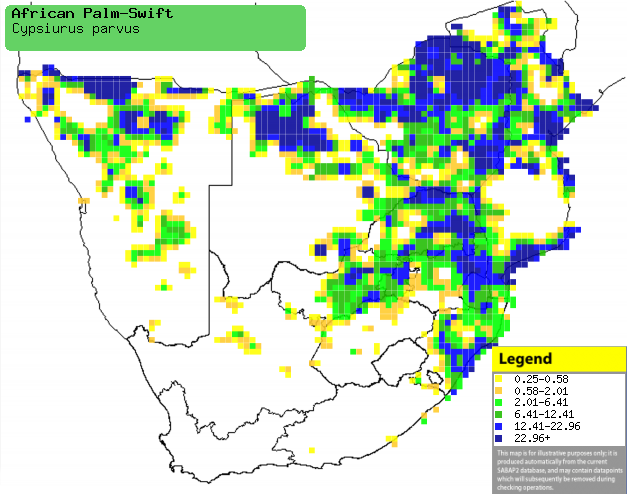|
Cypsiurus parvus (African palm-swift)
Palmwindswael [Afrikaans]; Sisampamema (generic term for
swallows, martins, swifts and spinetails) [Kwangali]; Nkonjana (generic term for
swift) [Tsonga]; Afrikaanse palmgierzwaluw [Dutch]; Martinet des palmes
[French]; Palmensegler [German]; Andorinhão-das-palmeiras [Portuguese]
Life
> Eukaryotes >
Opisthokonta
> Metazoa (animals) >
Bilateria >
Deuterostomia > Chordata >
Craniata > Vertebrata (vertebrates) > Gnathostomata (jawed
vertebrates) > Teleostomi (teleost fish) > Osteichthyes (bony fish) > Class:
Sarcopterygii (lobe-finned
fish) > Stegocephalia (terrestrial
vertebrates) > Tetrapoda
(four-legged vertebrates) > Reptiliomorpha > Amniota >
Reptilia (reptiles) >
Romeriida > Diapsida > Archosauromorpha > Archosauria >
Dinosauria
(dinosaurs) > Saurischia > Theropoda (bipedal predatory dinosaurs) >
Coelurosauria > Maniraptora > Aves (birds) > Order: Apodiformes >
Family: Apodidae
The African palm-swift originated in the lowland forests of
Equatorial Africa, but now it occurs across sub-Saharan Africa, preferring
savanna or urban areas with scattered palm trees. In the last 60-70 years its
range has expanded exponentially, due to human exploits and the planting of palm
trees. It usually lives in colonies of up to 100 active nests, which each
consist of a shallow cup, mostly made of feathers glued together with saliva,
normally placed on the upper side of palm fronds. Here it lays 1-2 eggs, which
the female immediately glues to the nest, using her own saliva. The eggs are
then incubated by both sexes, for 18-22 days. The chicks are brooded and fed by
both sexes, leaving the nest when they are about 29-33 days old, at which point
they become fully independent.
Distribution and habitat
Originated from the lowland forests of
Equatorial Africa, but now it occurs across sub-Saharan Africa, absent only from
the deserts of East Africa. In the last 60-70 years its range has expanded
exponentially, due to human exploits and the planting of palm trees. Within
southern Africa it is common in central and northern Namibia, northern and
eastern Botswana, Zimbabwe, Mozambique, Swaziland and north-eastern South
Africa. It generally prefers savanna with
scattered palm trees, but it can also move into towns with indigenous or exotic
palms, such as Livistona and Washingtonia.
|
 |
|
Distribution of African palm-swift in southern Africa,
based on statistical smoothing of the records from first SA Bird Atlas
Project (©
Animal Demography unit, University of
Cape Town; smoothing by Birgit Erni and Francesca Little). Colours range
from dark blue (most common) through to yellow (least common).
See here for the latest distribution
from the SABAP2. |
Predators and parasites
Food
It almost exclusively eats flying insects, hunting mainly
just above the tree canopy. It often forages in flocks, usually
with other swift and swallow species. The following food items have been
recorded in its diet:
Breeding
- Monogamous, solitary or colonial nester. It
usually lives in colonies of up to 100 breeding pairs, but it may
occasionally nest solitarily.
- Both sexes build the nest, which is a shallow cup of feathers
and plant detritus, glued together with saliva. It is usually placed on the
upper side of a palm frond, which is usually a Borassus palm (Borassus
aethiopum), Lala palm (Hyphaene coriacea), Northern Lala palm (Hyphaene petersiana),
or the alien genera Livistona and Washingtonia.
It may also place the nest in a building or steel bridge.
- Egg-laying season is year-round, peaking from August-November.
- It lays 1-2 eggs, which the female immediately glues to the nest using
her own saliva. The eggs are then incubated by both sexes for 18-22 days.
- The chicks are brooded and fed by both sexes, leaving the nest and
becoming independent when they are about 29-33 days old
Threats
Not threatened, in fact widespread and common.
References
-
Hockey PAR, Dean WRJ and Ryan PG 2005. Roberts
- Birds of southern Africa, VIIth ed. The Trustees of the John Voelcker
Bird Book Fund, Cape Town.
|
